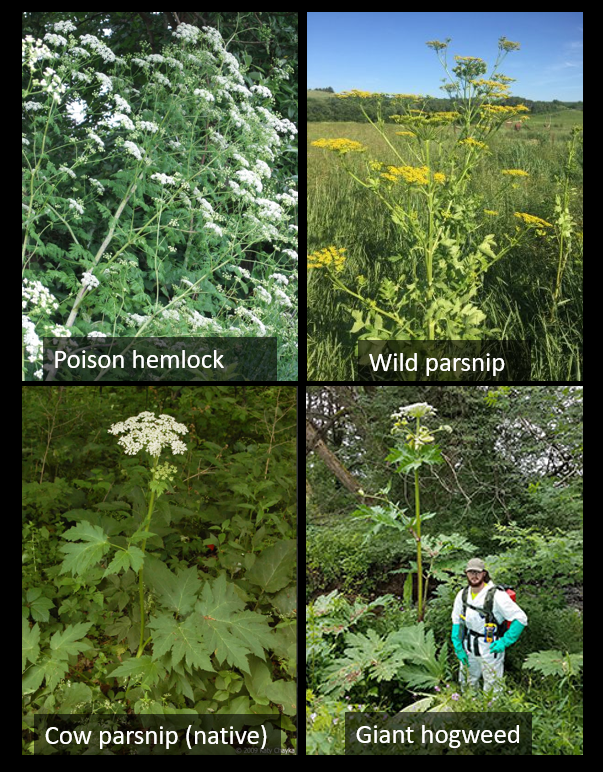The Skinny on Poison Hemlock
From Ellen Jacquart, INPS President…
A word on poison hemlock (Conium maculatum) and some of its relatives in the Apiaceae family. It is good that people are becoming more aware of the invasive species like poison hemlock which can cause harm to human health. However, there is some incorrect information out there about this species and its relatives and I’d like to clarify some things.
If your bare skin touches a poison hemlock plant it is unlikely to cause a rash or blisters. I say ‘unlikely’ because different people respond differently to plants and have can have varying degrees of sensitivity. To repeat – skin rash or blisters are generally not symptoms of poison hemlock. However, if the plant’s sap gets into a cut on your skin, or your eyes, or your nasal passages you could have impacts to your nervous system, vomiting, problems in movement and a whole host of other problems. That’s why it is suggested you avoid making contact with the plant, in case sap gets into cuts, eyes, nose, or mouth accidentally. But no blisters – yay!
Wild parsnip (Pastinaca sativa) is an invasive plant in the same family as poison hemlock, and this plant DOES cause blisters if you brush bare skin against the plant (again, some are more sensitive than others) followed by exposure to sunlight. The chemical that causes this is furanocoumarin. The blisters are large, they last for weeks, and leave burgundy scars that can last over a year. I’ve had it twice, and it is not pleasant.
For more information on wild parsnip and poison hemlock and how to ID and manage them, see this great blog – https://bygl.osu.edu/index.php/node/1763
Cow parsnip (Heracleum maximum) is a native plant in the same Apiaceae family, and it contains the same chemical that wild parsnip does and it can cause the same blistering if bare skin is exposed to its leaves followed by exposure to sunlight. Cow parsnip is found in moist woods and roadsides in many counties in the northern half of Indiana, but never gets very abundant (unlike wild parsnip and poison hemlock, which often form monocultures in the areas they are in).
Finally, the media darling of the Apiaceae, giant hogweed (Heracleum mantegazzianum) also contains the chemical that causes blisters. However, giant hogweed has only been found a few times in the past in Indiana, and those populations have been eradicated. It is a federal noxious weed and so reports of it go to the Division of Entomology and Plant Pathology for follow-up. I have also gotten many, many reports of giant hogweed in the state. The total number of proven reports of giant hogweed in Indiana is ….zero. Before reporting giant hogweed, I strongly suggest you look closely at this site – https://www.dec.ny.gov/animals/72766.html – which gives a detailed description of giant hogweed and how to tell it from all lookalike species. It’s really not hard to distinguish it. Are the flower clusters two feet across? If not, it’s probably not giant hogweed. 😊
Hope you find this helpful. –Ellen Jacquart

